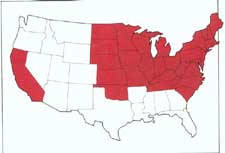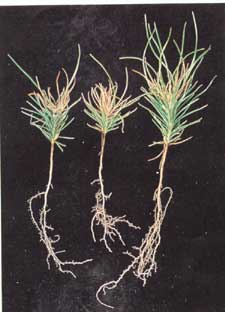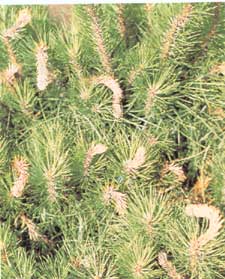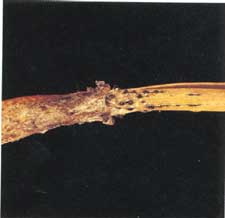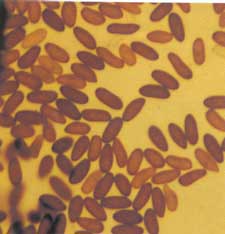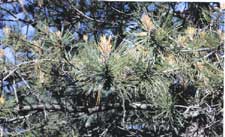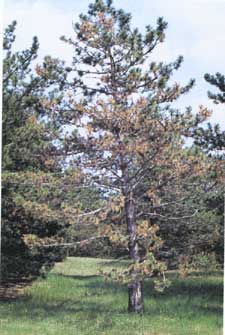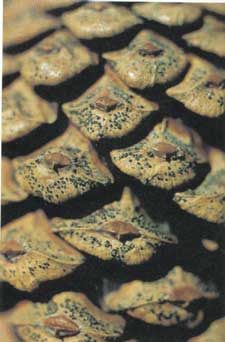Diplodia BlightGlenn W. Peterson - Plant Pathologist (retired), Rocky Mountain Forest and Range Experiment Station, USDA Forest Service, Lincoln, NE, and Cordell C.E., Anderson R.L., Hoffard W.H., Landis T.D., Smith R.S. Jr., Toko H.V., 1989. Forest Nursery Pests. USDA Forest Service, Agriculture Handbook No. 680, 184 pp. Hosts Diplodia blight, caused by the fungus Sphaeropsis sapinea (syn. Diplodia pinea), affects more than 20 pine species in the United States. Most commonly affected are Austrian, red, ponderosa, Scotch, Monterey, and mugo pines.
Diagnosis On infected seedlings, the current-year needles turn yellow, then brown, and finally ashen gray (fig. 3-2). Shoots often become curled (fig. 3-3). Pycnidia may be produced on the ashen gray needles. With a lOx hand lens, look for the small black pycnidia at the base of the needle (fig. 3-4). If pycnidia are not present, place needles or shoots in a moist chamber at room temperature and examine again. Spores, produced in the pycnidia, are brown at maturity, ellipsoid, usually one-celled, and about 30-45 x 10-15 microns in size (fig. 3-5).
On established pines occurring in and around the nursery, look for blighted foliage (fig. 3-6). The new shoots will look stunted and have short, brown needles (fig. 3-7). Pycnidia can usually be seen at the base of stunted needles infected the previous year and on scales of 2-year-old and older seed cones (fig. 3-8). Biology The fungus is present throughout the year in dead needles, second-year and older seed cones, bark and wood of infected trees, or on the ground. Pycnidia may develop a few weeks after infection; however, most pycnidia sporulate in the spring following the year of infection. Spores, which ooze out of pycnidia from March to October during wet weather or irrigation, are dispersed by splashing water. Most infection of nursery seedlings occurs on developing needles and shoots during rainy periods. Control Prevention - Establish seedling beds away from infected pines growing in windbreaks and landscape plantings. Avoid placing container-grown seedlings beneath older pines for the purpose of hardening-off seedlings. For windbreaks near seedling beds, select species other than pines. Cultural - Avoid using cone scales or pine needles for mulch; this practice could introduce the fungus into nursery beds. Irrigate in the morning, when seedlings will dry most quickly. Reducing the period when plants are wet lessens the chances of infection. Chemical - To reduce seedling infection, apply either benomyl or Bordeaux mixture at 2-week intervals throughout the spring and early summer until shoots and needles are mature. On infected trees adjacent to nursery beds apply two properly times applications of either benomyl or Bordeaux mixture. Selected References Palmer, M.A.; Nicholls, TH.; Croghan. C.F. 1986. Fungicidal control of shoot blight caused by Sphaeropsis sapineo on red pine nursery seedlings. Plant Disease. 70: 194-196. Peterson. Glenn W. 1981. Diplodia blight of pines. For. Insect & Dis. Leafl. 161. Washington. DC: U.S. Department of Agriculture. Forest Service. 7 p. Peterson. Glenn W.; Johnson. David W. 1986. Diplodia blight of pines. In: Riffle. Jerry W.: Peterson. Glenn W. tech. coords. Diseases of trees in the Great Plains. Gen. Tech. Rep. RM-129. Fort Collins, CO: U.S. Department of Agriculture, Forest Service. Rocky Mountain Forest and Range Experiment Station: 128- 129. |
Forest Pests: Insects, Diseases & Other Damage Agents |

|
|
